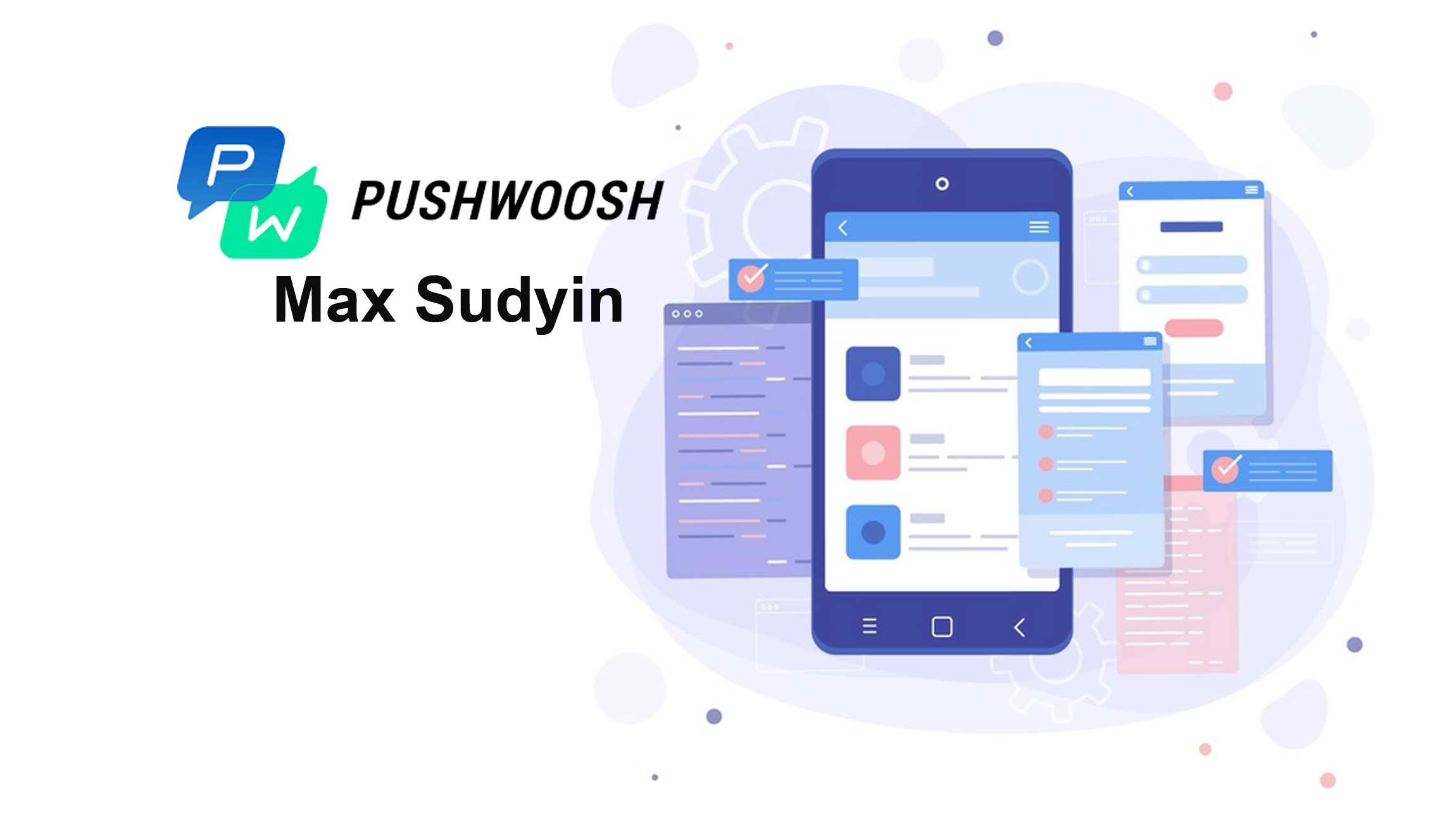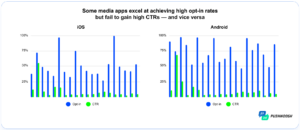Push notifications have long been known as an effective channel for driving user engagement in media apps. But once you decide to benchmark your efforts against other publishers, what numbers should you look at?
Pushwoosh has researched and analyzed the key push notifications metrics of 104 active news outlets. Average CTRs, opt-in rates, and daily frequency took the center stage in the push notification benchmark report.
Compare your app metrics to the averages below and consult the list of must-have technologies that stand behind leading media apps’ push notification success.
An average media app sends 6 pushes per day
Read it as the average, not the universal best practice for media apps.
In our research, we’ve found a large part of publishers sending a fewer number of pushes — 3 to 5 notifications daily. There are also those who send over 20 and even 30 pushes daily and stay relevant to their audience.
Tip: If you want to determine the ideal push notification frequency for your media app, the best thing to do is to experiment. Find out how your other metrics (such as CTR) change when you send fewer or more pushes daily.
Our research has only revealed a volatile correlation between push notification frequency and CTR, meaning the effectiveness depends more on the content and the audience that receives it.

Regarding CTRs, here is what we’ve found:
Media apps’ average CTR is 4.43% on iOS and 5.08% on Android
You may have noticed it for your own app too: push notification CTRs differ on iOS and Android.
The reason is, UX is different on these platforms. iOS hides pushes in the notifications center and leaves them invisible once a user unlocks the screen. Android, on the other hand, keeps push alerts glued to the top of the screen, and a user sees them every time they pull down the notification drawer.
Can media apps get higher click-through rates? Absolutely! An ambitious marketer may want to aim at the maximum CTRs that Pushwoosh has revealed: 55.59% on iOS and 68.9% on Android.
Tip: From Pushwoosh experience, media apps with the highest-performing pushes take their notification content as seriously as they would take an editorial piece.
To maximize your CTRs, pay closer attention to your push titles and subtitles and use more detailed audience segmentation. Target your notifications based on user preferences and content consumption history — this way, some of our clients have increased their push notifications CTR by up to 50%.
Should media app marketers always care about their notifications being clicked? Don’t rush with the answer: when it comes to news alerts and updates, users may read but never open them.
If at least some part of your pushes falls under the “news” category, you may want to care a bit less about their CTR and a bit more about their reach, i.e. your opt-in rates.
Marketing Technology News: MarTech Interview with Bibhakar Pandey, Vice President, Digital Customer Experience at Capgemini…
Average push notification opt-in rates vary from 43.89% on iOS to 70.91% on Android
Historically, higher opt-in rates on Android have been a norm: the platform gets users subscribed to app notifications by default — unlike iOS, where explicit user permission is required.
With the recent iOS 14.5 update, opt-in rates on Apple’s devices may drop even lower. Users may get irritated by, first, IDFA tracking requests, and then, push notification opt-in banners. And when the new iOS 15 is released, users may benefit from setting “Working” and “Sleeping” statuses for extended periods of time in order to keep notifications silent. What will happen to pushes’ CTRs then? We’ll see it before long.
Tip: Ensure higher opt-in rates with customized opt-in prompts. Offer a variety of topics your readers may subscribe to — users will engage more deeply with the content of their choice. For you as a media app marketer, this means refined segmentation and increased engagement and retention in the end.
Do average metrics depend on the size of the media app audience?
-
The number of pushes sent daily increases drastically with the audience growth.
Pushwoosh research has stated that media apps with a small userbase (less than 10K subscribers) send no more than three pushes per day. Major outlets, in the meantime, notify their readers of 15 updates daily.
-
CTRs are at max when a media app has 10–50K and then 100–500K subscribers
At first, user engagement peaks when a news outlet has acquired its “early adopters” — the first 50K subscribers. If a publisher continues to focus on user acquisition, a natural drop in CTRs takes place.
Those outlets who reprioritize their user engagement activities recover from this temporary CTR decrease soon. By the time their number of subscribers reaches 100k, they have normally carried out a number of A/B tests and accumulated deep knowledge of their audience preferences. Behavioral segmentation may come into play, contributing to the relevance of distributed pushes and their engagement rates.
-
Opt-in rates gradually decrease with the app audience growth on Android — but not on iOS
Many publishers start with push notifications being automatically allowed on Android. Unfortunately, the stats show that a media app may lose, on average, 14% of its push notification receivers.
This may happen due to poor segmentation, inappropriate timing, or exceeding frequency.
On iOS, we’ve only detected a drop in opt-in rates for media apps with 100–500K and 500K–1M subscribers. Publishers will smaller and larger app audiences enjoy almost equal and stable opt-in rates, according to our data.
Next steps after you’ve benchmarked your push notifications metrics against other media apps
The first question you may get is: “How do I improve my push notification campaigns to catch up with the leading media apps?”
Without looking into your strategy, we can recommend you check if you’re all set from a technological standpoint. This means you’d better have:
- A push notification solution that allows you (or your editorial team) to promote news quickly, without engaging a developer or taking too much time of an editor.
Imagine: when it only takes you a minute to distribute a piece of content with a push, you save seven full working days in the course of a year!
- Access to a high-speed push technology — if it is critical for you to deliver news faster than your competitors.
Remember those average CTRs for media apps we mentioned above? From our experience, when you speed up your push delivery, CTRs can reach 12% — this is at least twice the average.
- Sufficient personalization and segmentation options to ensure relevance of your pushes. Ideally, you should be capable of sending notifications based on user attributes, subscription preferences, and real-time behavior.
Normally, this is how media apps achieve to maximize their CTRs and triple the number of their push notification subscribers in a year.
- A/B testing features/tools and easy-to-use frequency settings — for your news to be treated like a long-waited update, not like an annoying spam message.
As we stated above, it’s not the number of pushes sent daily that counts — it’s their relevance. Experiment to find out what makes your audience click and stick to what keeps your readers engaged.
With these at your disposal, you should be capable of sending high-performing push notifications with maximum efficiency.
Marketing Technology News: MarTech Interview with Paige R Leidig, Chief Marketing Officer at NetBase Quid












